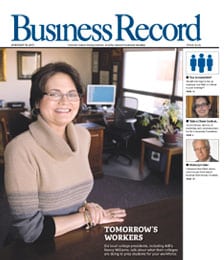High-end home inventory soars in Central Iowa

In September 2004, seven homes were listed for sale at a price of $1 million or more in Greater Des Moines; this past September, the inventory of million-dollar homes on the market had reached 17.
In the price category from $750,000 to $999,999, the local market had 14 listings a year ago; this past September, the number of active listings had grown to 34. Listings between $500,000 and $749,999 increased from 70 a year ago to 147 this fall.
If all of those homes had sold quickly, it would signal a still-expanding market for high-end homes in Central Iowa. However, September 2005 saw just one million-dollar sale, three sales in the next-highest category and 17 in the range from $500,000 to $749,999. In short, we have a lot of expensive houses waiting for a buyer.
“When we had extremely low interest rates, it created excess demand,” said Linda Busick, an independent real estate appraiser who serves on the Des Moines Area Association of Realtors board of directors and on the local Multiple Listings Service executive committee. Builders responded to that demand with a burst of activity. “Now that interest rates have moderated upward and excess demand has been met,” Busick said, “really, we’re in a normal market now; it was abnormal for a couple of years.”
Though demand might be normal, the inventory of high-end houses might not be.
The trend is evident further down the price scale, too. In the $450,000 to $499,999 category, listings increased to 90 from 65 and just five houses were sold in September 2005; in the $400,000 to $449,999 category, listings increased to 154 from 101 and 12 sales were made; from $350,000 to $399,999, listings rose to 234 from 143; and the $300,000 to $349,999 price range saw an increase to 342 from 225.
The statistics include a small number of “proposed construction” homes along with existing structures.
“We’re not in a bad market,” Busick said. “This is a good, active market. It’s just that prices are obviously flat because of the inventory, and they’ll stay that way until we reduce the inventory.”
Busick said those trying to sell used homes might find the competition especially tough. “When you’re competing with new construction, you can’t expect to get more for your house than you paid for it two or three years ago,” she said. “It’s like a car; as soon as you turn the key and walk in the door of a new house, you’ve depreciated it.”
Busick doesn’t expect the inventory to start decreasing until 2006. “In our market, home sales pick up in January, depending on the weather,” she said. “Historically, our highest sales months are March and April.”
Actually, the entire inventory of available houses looks a bit saturated to Busick, not just the high end. “Year to date, we’ve seen an overall increase in prices of 2 percent, and the number of sales is almost identically in line with last year,” she said. “The market is flat.”
Mike Knapp, president and CEO of market-dominating Iowa Realty, sees the picture differently. “The listing inventory we carry varies by season, but it looks like we’ve been within a couple hundred listings of where we were last year each month,” he said. “Some months were lower and some higher.”
Knapp said his company expects to sell more than 7,000 homes in 2005, about 3 percent more than in 2004, and that the average sale price will be slightly more than 2 percent higher. As for the high end of the market, “I have not heard among our managers or agents any concern related to lack of activity in those ranges,” he said.
Concern about high-end inventory has appeared in other markets. Last week, The New York Times reported that Toll Bros., the nation’s largest builder of luxury homes, predicted that it would sell fewer homes than previously expected over the next 12 months. The newspaper also quoted J. Patrick Lashinsky, a senior vice president at ZipRealty, a brokerage firm with office in 15 metropolitan areas, as saying, “In a lot of our markets, we’re seeing inventory levels up 20, 30 or 40 percent from a few months ago.”
Between August and September, the median sales price of existing homes fell 3.6 percent nationwide to $212,000, according to the National Association of Realtors.
Busick and Knapp both predicted that Central Iowa will continue to avoid the volatility that marks many other real estate markets.
“We don’t have the massive increases in prices like they do on the coasts,” Busick said, “and we also probably will not have a massive fallout.”
“I think we have far superior market conditions to what’s out there in a lot of places,” Knapp said. “The great news is that people who bought homes will continue to see an increased level of appreciation each year. It’s what the stock market can’t offer you. People do not want to invest in something that’s unreliable.”







